Here's an example of a typical gamesheet, although this design differed from book to book.
http://the-lost-and-the-damned.664610.n2.nabble.com/file/n2997150/ff01sheet.jpg
The FF series became a phenomenon in the 80s due in part to their popular interactive element but more importantly due to the exciting rule system that was the core of the FF series. As well as allowing the reader to control a fictional character, the books also acted as an ingenious game that a reader could play individually by his or herself. This was achieved through the use of a pair of six-sided dice, a pencil and a eraser and a basic game system. Using the dice before reading the background to the story, the reader or more correctly the player could create the fictional character's strengths and weaknesses.
This was determined through the rolling of the dice. These characteristics were known as SKILL, STAMINA and LUCK. The first characteristic, SKILL represented the fictional hero's physical prowess and fighting expertise. STAMINA represented the overall health and strength of the character which in turn affected their ability to survive wounds, fatigue, poison or disease. LUCK represented how naturally lucky a character was and this could often be used to enhance the success of attacks or help determine whether a choice or action was fortuitous or otherwise. The value of the SKILL and LUCK characteristics normally ranged between 1 and 12, adventurers starting with a number from 7 upwards (a single dice roll plus 6). STAMINA rated from 1 upwards with the fictional hero of the book starting with anything from 14 to 24 (the roll of two die plus 12). An adventure sheet provided with the book would allow a player to keep track of these scores and events occurring from start to finish.
Encounters with characters, creatures or monsters could occasionally lead to combat where SKILL values beyond 12 and STAMINA above 24 could be faced, but no one except players used a LUCK score. During combat, a player would be asked to roll two six-sided dice which would be added to their SKILL score to become ATTACK STRENGTH. The dice would in turn be rolled again and the result added to the opponent's SKILL score to become their ATTACK STRENGTH. Whoever's ATTACK STRENGTH was the higher would be the victor and the loser would have to deduct one or more points from their STAMINA until nothing remained, resulting in death. All characteristics however, could be restored through various methods such as magic, rest, potions or food.
Fighting Fantasy, What is Fighting Fantasy? Viewed 4th October 2011



















